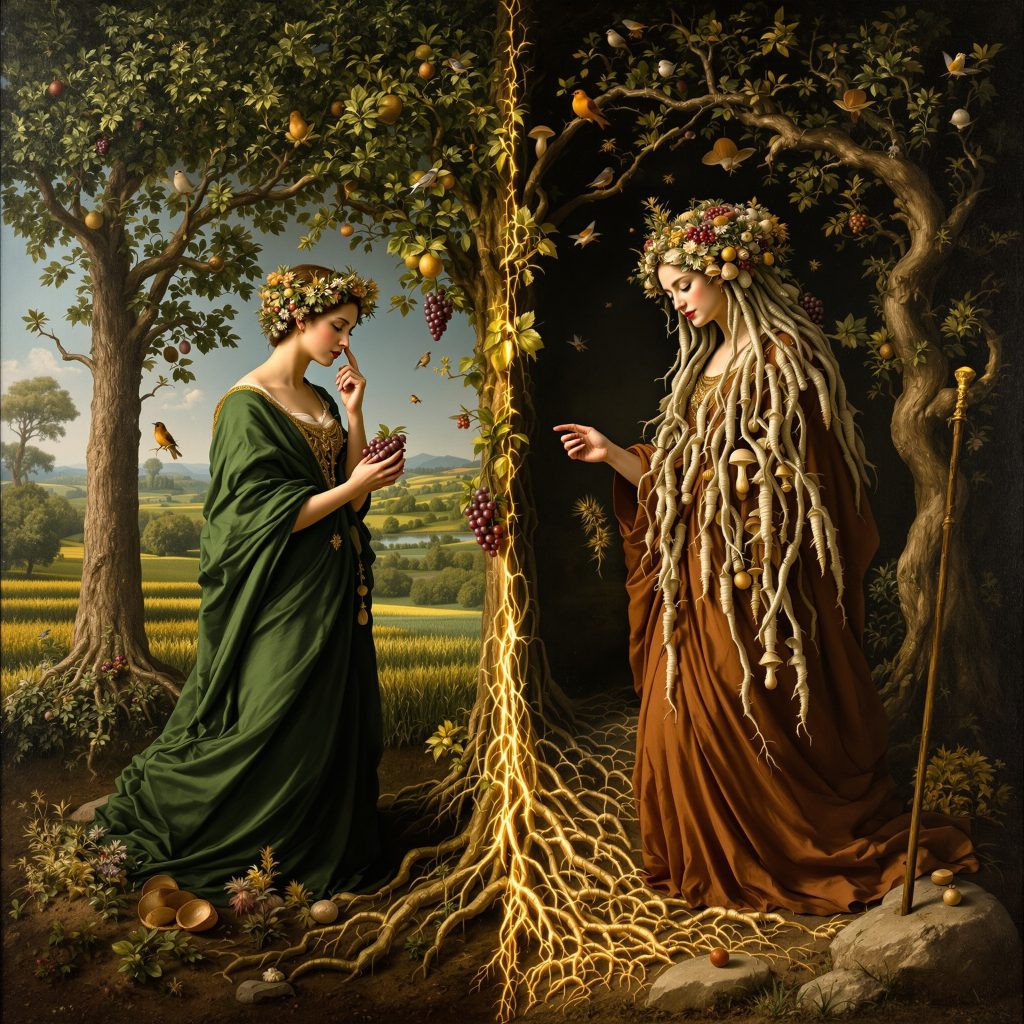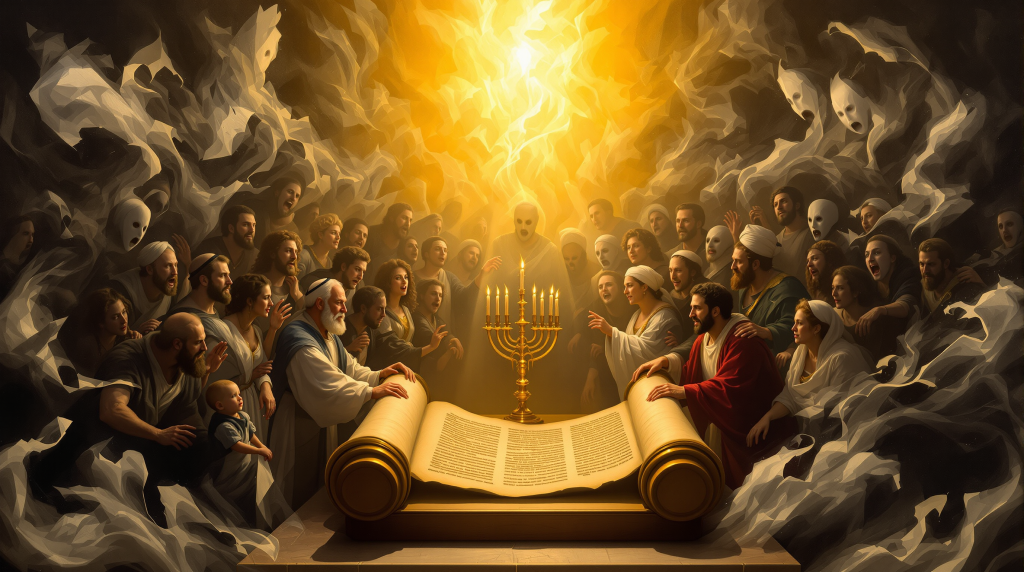PLEASE NOTE THIS FIRST EXAMPLE IS PUBLIC – SUBSEQUENT POSTS WILL BE PRIVATE AND ACCESSED BY PASSWORD FOR STUDENTS OF RABBI YEHOSHUA GELLER
A New Initiatve in collaboration between https://rachav.org & Rabbi Yehoshua Geller with help from Google Gemini Pro AI / NotebookLM Pro and Judaic Scholar AI

The Sambation River: Bridging Worlds Through AI
Where ancient wisdom meets modern learning. The Sambation River AI education initiative reimagines interfaith dialogue by weaving Jewish and gentile traditions into a shared digital learning space. Named after the legendary river that flows between worlds, our platform uses cutting-edge AI to dissolve historical divides—transforming the mythic into the meaningful, one conversation at a time.
Learn together. Understand deeper. Bridge further.
October 19, 2025 8:00 PM – 9:00 PM
Flora in the Torah: Flora in the Torah
Video Files
Audio Files –
A Deep Dive on this Week’s Shiur
An Audio Debate on the Shiur this Week
A Critique of the Shiur this Week
The Botanical Code: A Study Guide
The Living Metaphors of the Torah: Understanding Trees, Roots, and Seeds
Introduction: Nature’s Deep Lessons
Welcome. The Torah, in its profound wisdom, often uses powerful and relatable images from the natural world to teach deep spiritual lessons. These metaphors allow us to grasp complex ideas about our relationship with Hashem, our history, and our destiny through the tangible processes of growth, decay, and rebirth that we see all around us.
This document explores how three types of plant growth—from a visible trunk, from hidden roots, and from a brand new seed—are used as powerful symbols for the Jewish people’s journey. These botanical images map directly onto the cycles of destruction, survival, and redemption that define our national story. We will begin by exploring a core prophecy that introduces two distinct paths to renewal.
1. A Prophecy of Renewal: The Tree of Yishai
The prophecy in Yeshayahu (Isaiah) Chapter 11 is central to understanding the Jewish concept of redemption. It describes the coming of Mashiach (the Messiah) using two distinct botanical images of new growth emerging from the lineage of Yishai, the father of King David.
The prophet states that there will be:
- A “shoot” that emerges from the “stump/trunk (geza) of Yishai.”
- A “twig/shoot” that sprouts from its “roots (shoresh).”
At first glance, these might seem like two ways of saying the same thing. However, they describe two fundamentally different scenarios of survival and rebirth, each with its own profound spiritual meaning, grounded in botanical reality.
Botanical Reality: Two Kinds of Regrowth
| Growth from the Trunk (Geza) | Growth from the Roots (Shoresh) |
| Some trees, like the eucalyptus, can grow new branches and shoots directly from a cut trunk. | Other trees, like the olive tree, can send up entirely new shoots from their underground root system. |
| This happens when the trunk is damaged or cut down but is “not exactly dead.” A living core remains visible. | This can happen even if the trunk is completely gone and nothing is visible on the surface. |
| The new growth continues from the existing, visible structure. | This new growth is exceptionally fast because it draws energy from the established, hidden root system. |
Spiritual Insight: Hope for Every Situation
This dual metaphor provides a powerful message of hope for two different kinds of exile and destruction.
- Just as a eucalyptus can regrow from a damaged but visible trunk, Growth from the Trunk represents a redemption for those who, while damaged, still have a visible and existing connection to their heritage. This is a powerful symbol for the Babylonian exile. The nation was cut down, but its core—the “trunk”—was still identifiable and alive. Redemption came as a direct continuation of that living remnant.
- Just as an olive tree can sprout new life from its roots even when the trunk is gone, Growth from the Roots represents a redemption for those who seem “totally gone,” with nothing left on the surface. According to classic commentators like Rashi, this is a powerful symbol for the 10 lost tribes, who were exiled by Assyria and seemingly vanished from history. The prophecy teaches that even when all seems lost, a foundational connection exists deep underground, ready to sprout anew with incredible vitality.
While both of these scenarios describe the continuation of something that already exists, the Torah introduces a third type of growth for situations that require a completely fresh start.
2. The Power of a Seed: A Brand New Beginning
While shoots from trunks and roots represent a continuation, a seed represents a completely different kind of beginning. It is not about reviving what was, but about creating what will be. This metaphor is often connected to Avraham Avinu, who is considered the foundational “seed” of the Jewish people—a brand new start.
Growth from a seed has three key characteristics, each with a powerful symbolic meaning:
- Requires Transformation A seed must fundamentally transform—in a sense, it must “die”—to become a tree. It cannot remain what it is and also grow. This symbolizes the necessity of a complete break from the past to create something truly new and different.
- Grows Slowly A seed grows substantially slower than a shoot from an established root system. This slow growth is also a period of extreme vulnerability. As Yeshayahu notes, a new vineyard is “very, very delicate” and requires a “watchtower” for protection. This symbolizes that a new national beginning requires immense protection and Divine Providence to survive its fragile initial stages, representing a difficult and deliberate process that cannot be rushed.
- Creates Individuality A seed does not create an exact clone of its parent tree. It is a unique combination of traits with its own individual potential. This symbolizes Hashem’s desire for a new beginning, as if He is saying, “Be you!“—realize your own unique potential, don’t just be a copy of what came before.
These three paths—from the trunk, the roots, and the seed—give us a complete picture of the Torah’s vision for renewal.
3. Three Paths to Growth: A Comparison
We can now see how these three botanical paths represent three distinct states of being and three corresponding pathways to renewal.
| Type of Growth | Represents a State of… | The Path to Renewal is… |
| Growth from a Trunk | Partial Destruction | Continuation from a damaged, but still living, core. |
| Growth from Roots | Total Surface Destruction | Rebirth from a hidden, foundational source. |
| Growth from a Seed | A New Beginning | Creating something entirely new, full of unique potential. |
4. The Vine and its Supporters: Leaning on the Past
A final, powerful metaphor compares Am Yisrael (the Nation of Israel) to a grapevine. A vine has a unique characteristic: to achieve its potential and produce the best fruit, it cannot be left to itself. If left on its own, a vine sprawls aimlessly on the ground and fails to thrive. It must climb and rely on a support structure, such as a trellis.
The core insight here is what the trellis is made of. The supports used for a living, growing vine are often made of dead wood. This provides a stunning symbol:
The living nation (the vine) must rely on the legacy of its forefathers—the “dead wood” of Avraham, Yitzchak, and Yaakov—to climb, to thrive, and to achieve its greatest potential.
Our past is not a burden; it is the very structure that allows us to reach for the heavens.
Conclusion: Hope is Always Rooted
The Torah’s use of botanical metaphors provides a timeless and deeply encouraging message about the nature of growth, struggle, and redemption. These images are not just a menu of options, but a single, cohesive lesson on national resilience.
- Redemption has many forms. The Torah teaches that whether we feel partially damaged (a cut trunk), completely lost with no visible connection (only roots remain), or are starting completely fresh (a seed), there is always a path to growth and renewal.
- Our past is our strength. Like a vine needs a trellis to produce its best fruit, we draw essential strength and support from the foundational legacy of our forefathers.
- The journey creates the foundation. Most profoundly, these metaphors form a cycle. The difficult, slow, and imperfect process of starting from a “seed” is precisely what builds the strong trunk and deep roots of our nation. Even if the initial results are “wild grapes,” the effort itself creates the very foundation of Yishai that guarantees future survival. It is because of this foundational journey that new shoots can always emerge from the trunk after partial destruction, or from the roots even when all seems lost.
These living metaphors remind us that no matter the circumstance, hope is always rooted in the promise of rebirth, and our potential for renewal is as resilient and persistent as nature itself.
Quiz: Key Concepts
Answer the following questions in 2-3 complete sentences, drawing your information directly from the source material.
- Explain the primary biological and metaphorical distinction between new growth from a geza (stump) versus a shoresh (root system).
- What are the main advantages and disadvantages of propagating a plant from a shoot (sucker) compared to growing it from a seed?
- How does the rapid growth of a shoot emerging from an ancient root system create a legal complication with the Law of Orlah?
- Describe the central paradox of the grapevine’s (geffen) lifecycle and explain why this is essential for its fruitfulness.
- What is the symbolic significance of the common agricultural practice of raising a grapevine on “deadwood” such as stakes or a trellis?
- Explain the literal and metaphorical meaning of keren ben shamen and how it illustrates the transformation of adversity.
- In the context of the vineyard in Isaiah 5, why is the production of “wild grapes” (bashum) significant, even though the conditions for growth were perfect?
- How do the concepts of geza and shoresh serve as historical metaphors for the respective exiles of Judea and the 10 tribes of Israel?
- What principle regarding human effort and realized potential is illustrated by the myrtle (hadass) branch?
- Contrast the symbolic meanings of the olive tree and grass as they are presented in the discussion.
——————————————————————————–
Quiz Answer Key
- Growth from a geza (stump) represents recovery from visible, severe damage, where the main structure of the plant is still present but mutilated. Metaphorically, it signifies a return or rebuilding from a recognizable, surviving entity. In contrast, growth from the shoresh (roots) represents rebirth from a hidden, indestructible foundation, which allows for recovery even after the complete annihilation of the visible, above-ground structure.
- A shoot offers the advantage of rapid, efficient growth by leveraging the power of an established root system, ensuring continuity as a clone of the parent. However, it acts as a “sucker” that drains energy from the main plant and creates legal and horticultural management complications. A seed is substantially slower and requires a complete transformation (“death”) of its original form, but it offers the profound advantage of genetic variation and the potential for unique, improved offspring.
- The Law of Orlah forbids eating the fruit of a newly planted tree for three years. A shoot growing from a 100-year-old root system creates a legal debate: it is physically part of an ancient, mature tree, but it is also new growth. Its rapid maturation complicates the legal timeline and raises the question of whether it must undergo its own three-year period of immaturity or if it inherits the age of its parent system.
- The grapevine’s paradox is that its survival and fruitfulness depend on what is essentially an annual act of destruction. It requires drastic pruning each year, cutting back nearly all of the previous year’s branches. Without this intentional, severe renewal process, the vine becomes overgrown, tangled, and ceases to produce good fruit.
- Raising a vine on deadwood symbolizes the practical and profound necessity of relying on the past—such as the strength of forefathers or established history—to achieve present success. The living, fruit-bearing vine leans on a non-living support structure to stand upright and be productive. This illustrates a dependence on the foundational structures of the past, even after they have been surpassed.
- Keren ben shamen literally means “horn of oil” or “horn of fat” and refers to the corner of a mountain terrace. This prime location is not naturally occurring; it is created by the intensive labor of clearing stones from a hillside. Metaphorically, it represents how adversity (the stones) can be transformed into infrastructure (the terrace walls), turning poor ground into the most fertile spot.
- The production of bashum (worthless grapes) despite perfect conditions highlights the inherent risk associated with the “seed path,” which represents free will and the potential for variation. It suggests that even with a perfect foundation and divine effort, the choice for genuine creation over simple cloning means that initial outcomes can be faulty. This initial failure is presented as a natural part of a growth process that involves free choice.
- The exile of Judea to Babylon is compared to the geza. The kingdom was severely “cut down,” but the people and their identity remained a visible, recognizable entity that could physically return and rebuild. The 10 tribes exiled by Assyria are compared to the shoresh; their visible structure was completely eradicated from history, but the metaphor promises that their underlying foundation (the covenant or core promise) remains indestructible and capable of facilitating a future rebirth.
- The myrtle branch illustrates that human effort defines the quality of the final outcome. A high-quality myrtle for ritual use, with three leaves emerging from a single point, is the result of careful pruning, fertilizing, and general care from a farmer. A lower-quality branch from a neglected plant will have fewer leaves, symbolizing that human action is required to shape raw potential into its desired, most valuable form.
- The olive tree symbolizes endurance and peace, directly connected to its biological ability to resprout from its roots even after catastrophic destruction like a fire. Conversely, grass is used as a universal symbol for human frailty and transience. It springs up quickly and looks lush, but it withers just as fast, representing the fleeting nature of human life.
——————————————————————————–
Essay Questions
- Analyze the tension between continuity (shoots) and new creation (seeds) using the botanical details provided. Discuss the theological and practical implications of each path, including speed, risk, energy drain, and genetic variation.
- Using the detailed metaphor of the vineyard in Isaiah 5, explain how the text illustrates the themes of divine effort, free will, adversity, and failure. How do the biological realities of viticulture (pruning, soil preparation, support structures) enrich this metaphor?
- The discussion contrasts two forms of recovery from destruction: rebirth from a damaged but visible stump (geza) and rebirth from a hidden, indestructible root system (shoresh). Elaborate on these two models of redemption and apply them to the provided historical examples of the Babylonian and Assyrian exiles.
- The source suggests that ancient texts used horticulture as a “specialized, almost technical vocabulary.” Defend this assertion by citing specific examples of how the biological realities of the olive, date palm, myrtle, and grapevine are used to convey precise ideas about continuity, judgment, human effort, and renewal.
- The discussion concludes by posing a question about the bikkurim (first fruits). Synthesize the concepts of “beginnings” from the text—including the seed’s transformation, the shoot’s connection to an established source, and the risk of “wild grapes”—to explore why an imperfect beginning might be valued so highly over a later, more perfect outcome.
——————————————————————————–
Glossary of Key Terms
| Term | Definition |
| Bashum | Hebrew for wild, bad, or worthless grapes. Represents a faulty or imperfect outcome despite perfect growing conditions, symbolizing the inherent risk of free will and new creation. |
| Bikkurim | The Hebrew term for “first fruits.” These are noted as often being imperfect (smaller, less tasty) compared to later fruit, yet are considered the most special and are marked for dedication. |
| Dormancy | A unique capability of seeds to lie inactive in the soil for years, decades, or longer, preserving their potential for future growth even when all physical plant infrastructure has been destroyed. |
| Geza | (גֶּזַע) The Hebrew term for a tree trunk or stump. It refers to the visible, above-ground remnant of a tree that has been cut down, representing continuity and recovery from visible, severe damage. |
| Geffen | (גֶּפֶן) The Hebrew term for the vine or grapevine. Its lifecycle requires drastic annual pruning, symbolizing the necessity of intentional renewal through destruction to remain fruitful. |
| Growth Bulbs | Specialized structures within the root systems of trees like the olive, which store energy and allow for incredibly fast re-sprouting of new shoots after the visible tree has been destroyed. |
| Hadass | (הֲדַס) The Hebrew term for the myrtle tree. The quality of its branches for ritual use is dependent on the farmer’s effort, symbolizing how human care is required to realize potential. |
| Karen ben shamen | (קֶרֶן בֶּן שָׁמֶן) Hebrew for “horn of oil” or “horn of fat.” It refers to the fertile corner of a mountain terrace, created by human labor clearing stones, symbolizing the transformation of obstacles into productive infrastructure. |
| Law of Orlah | The law stating that the fruit of a newly planted tree cannot be eaten for the first three years. This law creates a legal complication for shoots that grow rapidly from ancient root systems. |
| Re-sprouting | The process by which new life emerges from the geza (stump) of a severely damaged but still-present tree. It is distinct from new shoots coming from underground roots. |
| Sheva Minim | The “seven species” of the land of Israel. Plants from this group, like the vine, olive, and date palm, are noted for their profound capability for rapid subterranean rebirth. |
| Shoresh | (שֹׁרֶשׁ) The Hebrew term for roots. It refers to the hidden, underground foundation of a plant, representing an indestructible core promise that allows for rebirth even after total surface annihilation. |
| Suckers | The horticultural term for young shoots that emerge from a plant’s roots or lower trunk. They are so named because they “suck” or draw essential energy away from the main, established plant. |
Design and Implementation of Sambation River
FoundationP at rachav.org – Peter Dixon 2025




